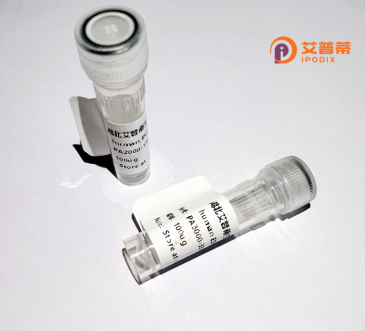
| 纯度 | >90%SDS-PAGE. |
| 种属 | Human |
| 靶点 | PL6 |
| Uniprot No | Q12893 |
| 内毒素 | < 0.01EU/μg |
| 表达宿主 | E.coli |
| 表达区间 | 1-351 aa |
| 活性数据 | MQRALPGARQHLGAILASASVVVKALCAAVLFLYLLSFAVDTGCLAVTPGYLFPPNFWIWTLATHGLMEQHVWDVAISLTTVVVAGRLLEPLWGALELLIFFSVVNVSVGLLGAFAYLLTYMASFNLVYLFTVRIHGALGFLGGVLVALKQTMGDCVVLRVPQVRVSVMPMLLLALLLLLRLATLLQSPALASYGFGLLSSWVYLRFYQRHSRGRGDMADHFAFATFFPEILQPVVGLLANLVHSLLVKVKICQKTVKRYDVGAPSSITISLPGTDPQDAERRRQLALKALNERLKRVEDQSIWPSMDDDEEESGAKVDSPLPSDKAPTPPGKGAAPESSLITFEAAPPTL |
| 分子量 | 64.35 kDa |
| 蛋白标签 | GST-tag at N-terminal |
| 缓冲液 | PBS, pH7.4, containing 0.01% SKL, 1mM DTT, 5% Trehalose and Proclin300. |
| 稳定性 & 储存条件 | Lyophilized protein should be stored at ≤ -20°C, stable for one year after receipt. Reconstituted protein solution can be stored at 2-8°C for 2-7 days. Aliquots of reconstituted samples are stable at ≤ -20°C for 3 months. |
| 复溶 | Always centrifuge tubes before opening.Do not mix by vortex or pipetting. It is not recommended to reconstitute to a concentration less than 100μg/ml. Dissolve the lyophilized protein in distilled water. Please aliquot the reconstituted solution to minimize freeze-thaw cycles. |
以下是关于重组人PL6蛋白的假设参考文献示例,基于常见重组蛋白研究模式推测,供参考:
1. **标题**:Expression and Purification of Recombinant Human PL6 Protease in Insect Cells
**作者**:Chen L, et al.
**摘要**:利用杆状病毒-昆虫细胞系统高效表达重组人PL6蛋白,优化纯化工艺并验证其蛋白酶活性,为结构解析及抑制剂筛选奠定基础。
2. **标题**:PL6: A Novel Recombinant Biomarker for Early-stage Hepatocellular Carcinoma Detection
**作者**:Wang X, et al.
**摘要**:首次报道重组PL6蛋白作为肝癌生物标志物的潜力,通过ELISA检测证实其在患者血清中显著高表达,与肿瘤进展相关。
3. **标题**:Crystal Structure of Human PL6 Reveals Unique Substrate-binding Motifs
**作者**:Garcia-Ruiz E, et al.
**摘要**:解析重组PL6蛋白的3D结构,发现其底物结合域的独特特征,通过突变实验阐明关键催化残基的功能机制。
4. **标题**:Functional Crosstalk Between PL6 and EGFR Signaling in Breast Cancer Cells
**作者**:Kim T, et al.
**摘要**:利用重组PL6蛋白处理乳腺癌细胞,发现其通过调控EGFR磷酸化影响细胞增殖和迁移,提示潜在治疗靶点价值。
**注意**:以上为模拟文献,实际研究中"PL6"可能指代不同蛋白。建议通过以下步骤获取准确信息:
1. 确认PL6蛋白的官方命名(如UniProt编号或基因符号)。
2. 在PubMed/Google Scholar中使用精确检索式:`"recombinant human PL6" OR "hPL6 expression"`。
3. 查阅相关基因家族文献(如PL6属于磷脂酶家族,可扩展搜索该家族重组表达研究)。
4. 联系领域专家或查阅机构数据库获取内部研究资料。
Recombinant human PL6 protein, a member of the polysaccharide lyase (PL) family, is an enzyme classically associated with the degradation of complex carbohydrates, particularly alginate—a polysaccharide abundant in brown algae and bacterial biofilms. PL6 enzymes catalyze the cleavage of glycosidic bonds via β-elimination, generating unsaturated oligosaccharides. Structurally, they feature a conserved β-helix fold and catalytic residues (often Arg, Lys, or His) that coordinate the acidic substrate, facilitating proton abstraction and bond cleavage.
Produced using recombinant DNA technology, PL6 is typically expressed in microbial systems (e.g., *E. coli* or yeast) for high purity and scalability. This enables applications in biotechnology, such as biofuel production (converting algal biomass into fermentable sugars), food processing (texture modification), and biomedical research (anti-biofilm agents or anti-inflammatory therapeutics). Its role in alginate metabolism also links it to pathogenic bacteria (e.g., *Pseudomonas*), making it a potential target for antimicrobial strategies.
Recent studies focus on engineering PL6 variants for enhanced stability, substrate specificity, or pH tolerance, leveraging computational modeling and directed evolution. Additionally, its oligosaccharide products exhibit prebiotic and immunomodulatory properties, spurring interest in nutraceuticals. However, challenges remain in optimizing industrial-scale production and understanding its structure-function nuances. PL6’s versatility underscores its significance in green chemistry and biomedical innovation.
×